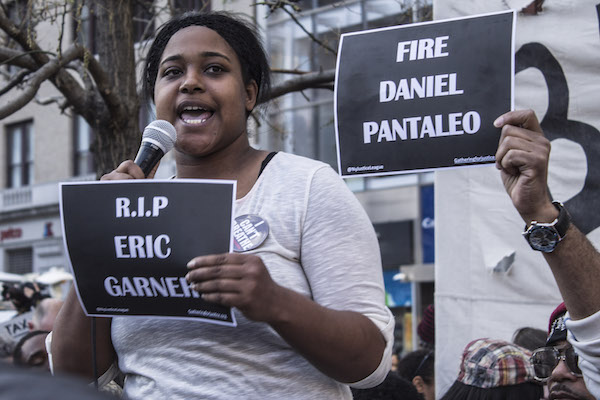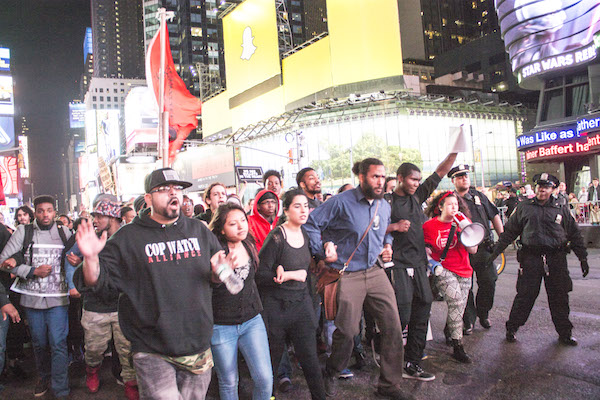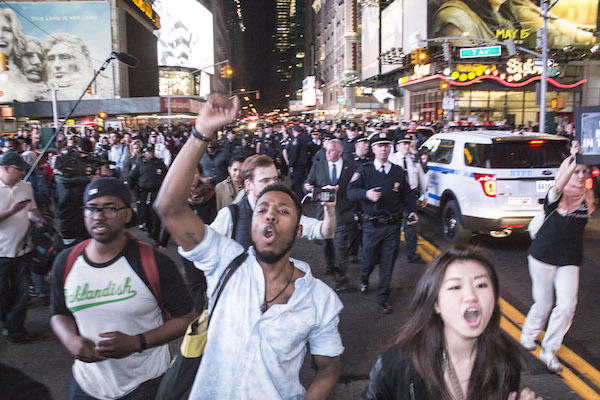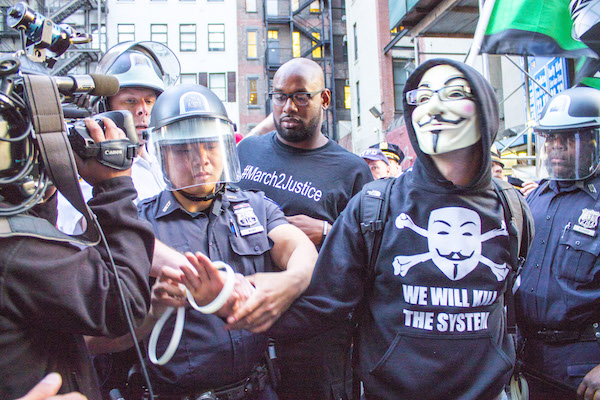
Erica Garner speaks at an April 29 rally in Union Square. Her father, Eric, died last summer in Staten Island during an attempted arrest for selling untaxed cigarettes.
BY ZACH WILLIAMS | The NYPD displayed little tolerance for #BlackLivesMatter activists who took to the streets on April 29 in a renewed push to highlight police violence against people of color.
About 1,000 people attended a rally that evening at Union Square where activists struck a more forceful tone than prior demonstrations, during which both police and activists largely avoided conflict beyond isolated cases. Several speakers remarked that activists should disregard warnings from the NYPD (disseminated via leaflet and loudspeaker) that protesters would be arrested if they marched in the streets.

A splinter group broke off from the Union Square rally (seen here marching down Seventh Ave. in Times Square).
“We’re exercising our constitutional rights and will ignore them,” said Akua, an organizer with Millions March NYC who declined to give her last name.
The event was held in solidarity with activists in Baltimore, where protests erupted following the April 19 death of Freddie Gray, a black man who died following an injury sustained under unclear circumstances while in police custody following an arrest for possession of a switchblade knife. That event followed the April 4 fatal shooting of Walter Scott in South Carolina, which inspired #BlackLivesMatters activists to congregate at Union Square on April 14 in what had been their most high-profile demonstration in months.
Speakers on April 29 included several relatives of victims of police violence including Erica Garner whose father, Eric, died last summer in Staten Island during an attempted arrest for selling untaxed cigarettes. Hertencia Petersen told the crowd that the movement should address elected officials such as Mayor Bill de Blasio and President Obama — both of whom, Peterson noted, counted on the Black vote during election season but have yet to adequately address the underlying reasons for police-related deaths in her opinion.

Police kept in close proximity to activists, and began making arrests as soon as they set foot in the street.
“The injustice that has been prominent against black and brown lives in urban communities must end. NYPD and all police departments worldwide have unjustified preconceived attitudes and opinions towards black and brown lives and their work is unacceptable and they must be held accountable,” Peterson said.
Rookie NYPD officer Peter Liang fatally shot Peterson’s nephew, Akai Gurley, as he made his way down the stairwell of an East New York housing project last November. Liang was indicted for manslaughter in February — a noted contrast to other cases such as Garner and Michael Brown in Ferguson, M.O. where the lack of indictments against involved officers inspired the advent of the movement late last year.
Police largely let them march in the streets on many occasions until April 29, when they took a harder line. As the assembled activists made their way out of Union Square at about 7 p.m. they quickly ran into dozens of police blocking their way about a half block down W. 17th St. The first dozen of at least 100 arrests that night occurred as police first divided the crowd along opposite sidewalks before splitting it into quarters at the intersection of the street with Union Square West.
The energy of the march seemed depleted at that moment, with some activists expressing dismay that the action had met its match so quickly in the form of aggressive NYPD crowd control. Activists noted that they understood the passion behind rioting, which took place in Baltimore after the death of Gray, but added that activists in New York City have not participated in such behavior.

An arrest is made near Union Square. By the end of the night, roughly 100 people were taken into police custody.
“Certain parts of the media just portrays our African-American brothers and sisters as criminals and thugs and n—rs and just looting and messing up the community. Yes, (rioting is) wrong but that’s one of our ways of expressing how we feel,” said Taven Gibson, 23, a Harlem resident.
By 7:30 p.m. (after about a half-hour of inaction), the activists split into separate marches with one of them winding its way to the West Side, through Chelsea to the Times Square area where they reassembled with other marchers. Police lined up along a cross street as the protesters filled the square before continuing southbound along Seventh Ave.
The night’s biggest clashes erupted just south of the square, when activists began marching in the street itself yet again. Police soon pushed them back with clubs, shoves and arrests. Activists then began turning westbound on W. 43rd St. in an effort to evade law enforcement. Further clashes and arrests transpired in the vicinity including, the arrest of this reporter for allegedly obstructing traffic while taking photographs.
Frustrated activists said earlier that while the NYPD was succeeding in controlling the march, such protests would continue as well as political maneuvering behind the scenes in the coming months.
“We are going to our local state and federal to discuss reform around policing. We are working on various campaigns and there is public direct action so this will continue, continue to accelerate and you will see more and more of us throughout the summer,” said Monica Dennis, one of the speakers at the Union Square rally, in an interview.


































